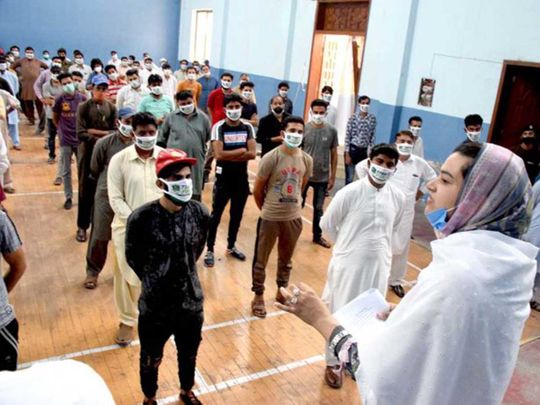
Dubai: Pakistan has started ‘pool testing’ of COVID-19 suspects across the country in a bid to scan maximum number of people in a short span of time andd with limited resources.
The health authorities in the country have been preparing for the ‘pool’ or ‘group’ testing for weeks and the process has already started in various hospitals across the country, a senior official told Gulf News from Islamabad.
“The mass testing will help increase the capacity of testing more people within the given limited resources,” he added. More tests can be conducted with fewer testing kits.
Pool testing is a way to screen large number of people for COVID-19 even if they are asymptomatic.
Sample of several people from a household, or an area, are taken by collecting specimens from their nose or throat. The swabs are then mixed in a tube and tested by the real-time polymerase chain reaction (RT-PCR) technique altogether.
On testing, if the pooled samples result in a combined negative, then all samples in the pool are cleared. If not, then each sample is individually tested to identify people who are infected with coronavirus.
More tests in less time
The official said that the testing strategy speeds up results, as each swab does not require a diagnostic kit. Moreover, it reduces pressure on laboratories, does not require a large number of testing kits, helps trace out potential virus carriers, especially those with no symptoms, and can ultimately assist in combating the spread of the deadly virus.
Pool testing is all the more important for Pakistan with a population of 220 million people with limited testing capabilities. The country has tested around 305,800 people only so far with 32,674 confirmed COVID-19 cases. Some 724 deaths have been reported due to coronavirus while 8,555 have recovered. Currently, around 10,000 tests are being conducted every day. Pool testing will increase the testing capacity by three to four times.
Pool testing in Germany
Earlier, a number of other countries including Germany and a few states in North America have implemented the technique with encouraging results. In Germany, the German Red Cross Blood Donor Service, Frankfurt, combined the samples of 50 patients. As per the Science, an online medical journal, around 19 test kits would be sufficient to test 100 individuals.
According to Health Europa, which provides information about European Health Policy, a team of scientists in Germany has developed a new procedure called ‘pool testing’ that will help increase coronavirus testing capacity.
It says that the development will help to increase coronavirus testing capacity in order to meet the high demand for testing in the mass screening programmes needed in the early identification and isolation of asymptomatic individuals.
The pooling of samples before testing is a well-established and safe procedure in blood banking and now, the team from the Institute of Virology has adapted and tested this method for use in coronavirus diagnostics, it further explains.
What is pool testing for COVID-19
In pool testing, samples from several individuals are pooled and tested together in a single tube using sensitive molecular biological detection methods. Only if the pool result is positive, samples need to be tested individually. When the infection rate is low and only a few people are infected, pool testing can significantly expand the testing capacity of the existing laboratory infrastructure.
Sigrun Smola, Professor of Virology at the Saarland University and Director of the Institute of Virology at Saarland University Hospital, said: “To protect those groups with a high mortality risk from the coronavirus, we need to prevent the introduction of the virus from asymptomatic individuals, including the medical and care staff that look after them.
“Groups most at risk include chronically ill hospital patients, such as those with cardiovascular disease or cancer, the elderly and, most especially, the residents of nursing homes and residential care homes. Prevention is only possible if we use large-scale testing to identify asymptomatic contact persons and thus avert infection of the most vulnerable.”








